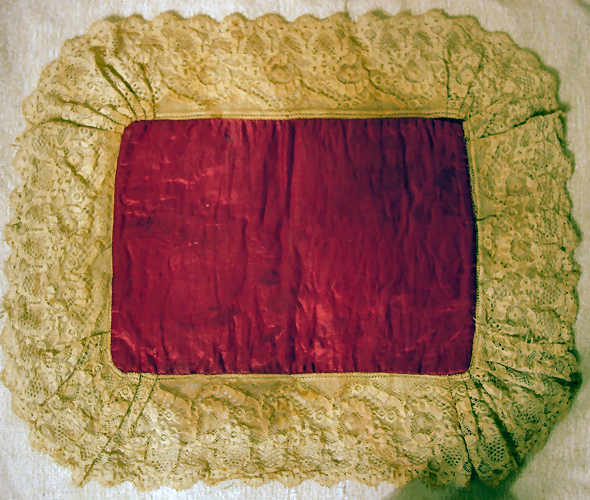

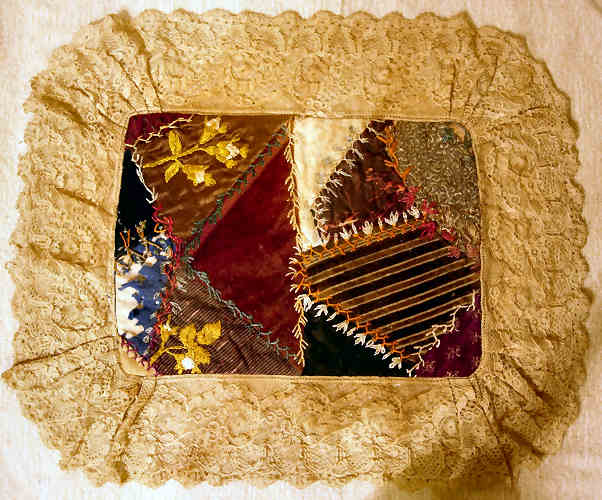
![]() Some, but not many, aspects of child-rearing has changed over the centuries. Today children are revered and adored, their status being just below that of angelic cherubs. But at one time, children were tolerated, at best. They were, as noted in the famous proverb, 'meant to be seen and not heard'.
Some, but not many, aspects of child-rearing has changed over the centuries. Today children are revered and adored, their status being just below that of angelic cherubs. But at one time, children were tolerated, at best. They were, as noted in the famous proverb, 'meant to be seen and not heard'.
![]() Children were, no doubt, loved as much by their parents in the 1700s as they are today, but daily life was quite different in the 1700s than it is today, and children were, understandably, treated differently. Men and women, alike, worked from sunrise to sunset: the men in the fields, planting crops and harvesting the same, or taking care of livestock and performing farmwork; the women cooking, washing the family's clothes and spinning flax and wool into thread. There wasn't much time left for either of the parents to spend playing with their children, and so the children were left to fend for themselves. But guess what? We're alive today ~ proof that apparently not all of the children of the 1700s died because they weren't coddled or pampered.
Children were, no doubt, loved as much by their parents in the 1700s as they are today, but daily life was quite different in the 1700s than it is today, and children were, understandably, treated differently. Men and women, alike, worked from sunrise to sunset: the men in the fields, planting crops and harvesting the same, or taking care of livestock and performing farmwork; the women cooking, washing the family's clothes and spinning flax and wool into thread. There wasn't much time left for either of the parents to spend playing with their children, and so the children were left to fend for themselves. But guess what? We're alive today ~ proof that apparently not all of the children of the 1700s died because they weren't coddled or pampered.
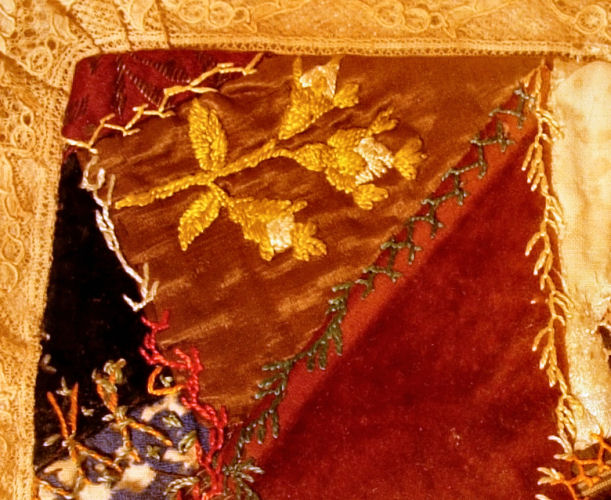
![]() Coddling and pampering aside, one thing that has not changed through the centuries is the desire of parents that their children would be safe from harm. It is often claimed by historians that the infant mortality rate was high, and to compensate for that, parents gave birth to numerous children. But there are other sources that confute that claim, countering that the percentage of children who died in infancy then was no greater than now: the lack of contraceptives might have been a greater factor in the size of families. Whether a family included three children or thirteen would not have influenced how much the parents loved those children. And the loss of any one of their children would surely have broken the hearts of those parents as much then as now. One difference between the 1700s and today, in regard to child-rearing, is that we currently have the results of many studies that show us what works and what doesn't. Ensuring that our children are safe from harm doesn't have to rely on trial and error any longer. But trial and error, with infant deaths resulting here and there, was the only thing parents had in centuries past. Instead of being able to reap the benefits of an extensive study, as parents can in the present day and age, parents of the 1700s either had to discover their own way, or learn from their elders.
Coddling and pampering aside, one thing that has not changed through the centuries is the desire of parents that their children would be safe from harm. It is often claimed by historians that the infant mortality rate was high, and to compensate for that, parents gave birth to numerous children. But there are other sources that confute that claim, countering that the percentage of children who died in infancy then was no greater than now: the lack of contraceptives might have been a greater factor in the size of families. Whether a family included three children or thirteen would not have influenced how much the parents loved those children. And the loss of any one of their children would surely have broken the hearts of those parents as much then as now. One difference between the 1700s and today, in regard to child-rearing, is that we currently have the results of many studies that show us what works and what doesn't. Ensuring that our children are safe from harm doesn't have to rely on trial and error any longer. But trial and error, with infant deaths resulting here and there, was the only thing parents had in centuries past. Instead of being able to reap the benefits of an extensive study, as parents can in the present day and age, parents of the 1700s either had to discover their own way, or learn from their elders.
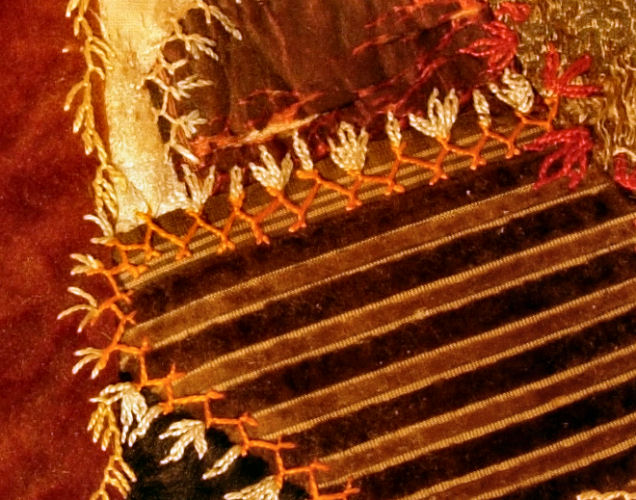
![]() The object displayed in this post is one of the things that parents learned from their elders and used to ensure that their baby did not die in its sleep. Although it appears to be just a fancy cloth item, similar to a doily, which is an ornamental cloth or paper mat used to protect furniture surfaces or to contribute, visually, to the presentation of something. The primary reason this object resembles a doily is due to the lacey border material. But if not a doily, what is it? It looks too delicate to be a wall hanging. And besides, dating from the late-1700s to the mid-1800s, the item's age would preclude it from being a miniature quilt created solely for the purpose of being hung on the wall as a decoration. Prior to the recent century, women did not waste their precious cloth scraps or thread to create miniature quilts and such to hang as artwork on a wall. Perhaps the item exhibited here was a 'sampler' ~ a cloth article created by a young girl on which to practice, and show off, her skill at sewing and embroidery. But, although the item certainly exhibits a variety of stitches and sewing techniques, the 'standard' structure of a sampler is absent. Samplers tended to be constructed of linen material; this item is comprised of silk and velvet. Samplers tended to showcase the letters of the alphabet sewn onto the linen in order to reveal how proficient the young girl was in using the needle; this item bears no letters at all. The actual purpose of this item may surprise you.
The object displayed in this post is one of the things that parents learned from their elders and used to ensure that their baby did not die in its sleep. Although it appears to be just a fancy cloth item, similar to a doily, which is an ornamental cloth or paper mat used to protect furniture surfaces or to contribute, visually, to the presentation of something. The primary reason this object resembles a doily is due to the lacey border material. But if not a doily, what is it? It looks too delicate to be a wall hanging. And besides, dating from the late-1700s to the mid-1800s, the item's age would preclude it from being a miniature quilt created solely for the purpose of being hung on the wall as a decoration. Prior to the recent century, women did not waste their precious cloth scraps or thread to create miniature quilts and such to hang as artwork on a wall. Perhaps the item exhibited here was a 'sampler' ~ a cloth article created by a young girl on which to practice, and show off, her skill at sewing and embroidery. But, although the item certainly exhibits a variety of stitches and sewing techniques, the 'standard' structure of a sampler is absent. Samplers tended to be constructed of linen material; this item is comprised of silk and velvet. Samplers tended to showcase the letters of the alphabet sewn onto the linen in order to reveal how proficient the young girl was in using the needle; this item bears no letters at all. The actual purpose of this item may surprise you.
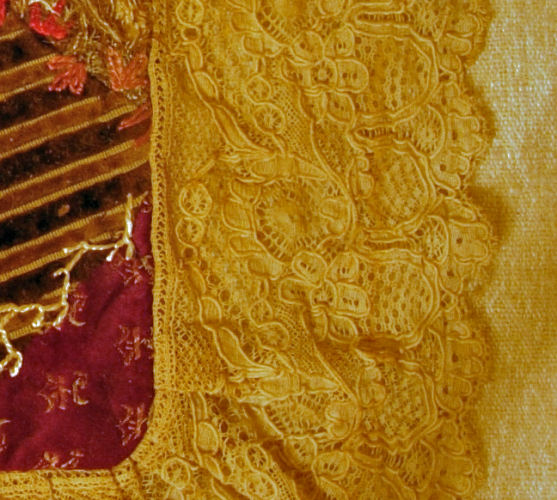
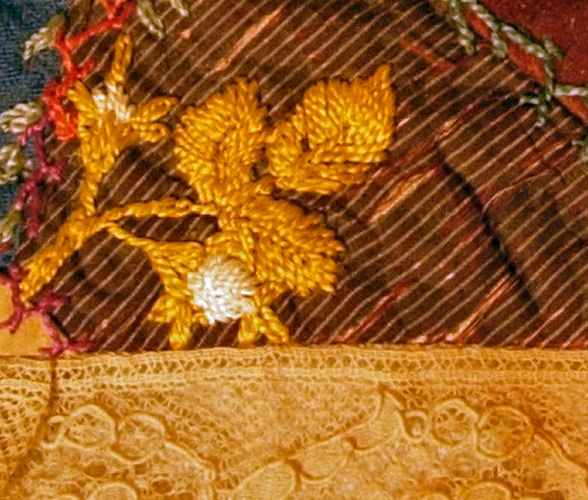
![]() The object of this post was intended to be placed in an infant child's cradle or crib, on which to rest the baby's head. The object is completely flat, and does not resemble what we today would call a 'pillow', but a baby's pillow is just what the object is. Through trial and error, mothers learned that a baby's head should not be lain on a fluffy or plush pillow with the risk of the baby suffocating. But all the same, mothers wanted to fawn over their little ones, and so made these cloth items to brighten the baby's cradle. The mother who sewed together this beautiful example used various types of cloth, including velvets and silks, and then added a border of intricately designed lace. The back, shown below, was constructed of a piece of red silk. The baby whose head rested on this beautiful pillow was very fortunate to have a mommy who loved him or her very much.
The object of this post was intended to be placed in an infant child's cradle or crib, on which to rest the baby's head. The object is completely flat, and does not resemble what we today would call a 'pillow', but a baby's pillow is just what the object is. Through trial and error, mothers learned that a baby's head should not be lain on a fluffy or plush pillow with the risk of the baby suffocating. But all the same, mothers wanted to fawn over their little ones, and so made these cloth items to brighten the baby's cradle. The mother who sewed together this beautiful example used various types of cloth, including velvets and silks, and then added a border of intricately designed lace. The back, shown below, was constructed of a piece of red silk. The baby whose head rested on this beautiful pillow was very fortunate to have a mommy who loved him or her very much.
